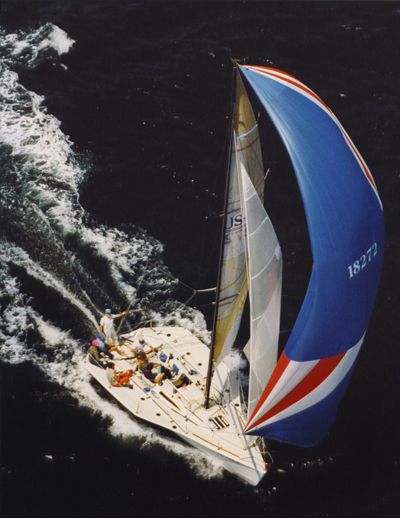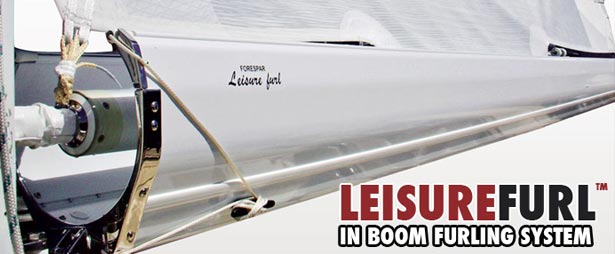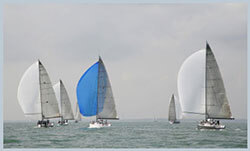LIGHTNING PROTECTION FOR BOATS: A THREE-PRONGED ATTACK
At any given moment, there are some 1,800 active electrical storms throughout the world, producing 100 lightning flashes per second, or about 8,000,000 lightning flashes per day. About 20%, or 1,600,000 of these flashes, are cloud to ground. All it takes is one strike to your boat to ruin your whole day.
For the past 200 years, lightning protection has been centered around the traditional lightning rod. The lightning rod has come to represent lightning protection. But, what about damage caused by other than a direct strike? What about high exposure installations where a conventional lightning rod system may not be entirely practical, or where it may not be enough – what about a boat?
THE LIGHTNING PHENOMENON
As the storm cloud builds, various mechanisms create a stratified charge within the storm cloud, with an electrical charge at the base of the cloud. As the storm cloud travels through the atmosphere, it induces an opposite charge on the surface of the earth. A simple way to look at it is to remember that like charges repel and opposite charges attract. The charge on the base of the storm cloud simply pushes away the same charge on the surface of the earth beneath it, and draws in and concentrates a “shadow” of opposite charge beneath it.
As the storm cloud travels along over the earth’s surface, it drags the ground charge along beneath it. When the ground charge reaches your boat, the storm cloud charge pulls it up on your boat. If, before the storm cloud travels away, it manages to concentrate enough ground charge on your boat so that the difference in potential between the storm cloud charge and your boat exceeds the dielectric strength (resistance to conducting electricity) of the intervening air, the air breaks down electrically, and a potential equalizing arc occurs; a lightning strike.
When the intervening air breaks down, the strike itself begins with the propagation of stepped leaders. Stepped leaders originate within the cloud charge, and extend in jumps of a few hundred feet at a time towards the earth. These are the wispy, downward reaching branches of light you see in photograph of a strike. When the stepped leaders reach to within several hundred feet of the ground, the rapidly building electrical field on the ground causes objects on the ground to break down electrically and respond by emitting streamers to jump upward. When a stepped leader and a streamer meet, the ionized channel becomes the path for the main lightning discharge. The other stepped leaders and streamers never mature, and disappear.
When the ionized path is completed, the current discharge occurs. Although a lightning strike appears to be a single flash, it is actually a series of flashes. Lightning flashes for approximately one one-thousandth of a second then shuts off for about two one-hundredths of a second, flashes for one one-thousandth of a second then shuts off for about two one-hundredths of a second. This process repeats until the potential differential is no longer sufficient to continue the discharge. Occurrences of lightning flashing over forty times within a single strike have been recorded.
The above applies to a negative, or so-called ground strike. During a positive, or ground-to-cloud strike, the charges and direction of propagation are reversed.
LIGHTNING DAMAGE
An average lightning strike conveys about 20,000 amps, and discharges of up to 200,000 amps can occur. The temperature of the core of the strike can reach 30,000 degrees Kelvin; five times the surface temperature of the sun. This current flow and heat build-up can cause physical damage and fires. In an effort to continue to ground, a strike to your masthead may arc from a shroud chain plate to the water, leaving a burn mark down the side of your boat. Or, worse yet, if the path to ground is through your keel stepped ungrounded mast, lightning may burn through the bottom of your boat. At least any resulting fire is extinguished when the boat sinks.
Another source of lightning damage is found in the secondary effect. During a lightning strike, the point on the surface of the earth at which the strike occurs is relatively vacated of ground charge. The area surrounding the point of the strike remains highly charged, causing an almost instantaneous potential gradient across the area. The surrounding area releases its charge to the point at which the strike occurred, causing a flow of current. This current flow can arc across any gaps in its path. If that arc takes place within a flammable material, it can cause a fire or explosion. Id it takes place on a circuit board, it can damage the circuit board. If the arc takes place within a bearing, it can scar the bearing and cause premature wear. If the arc takes place between the stern pulpit and the wheel, it can scar the helmsman.
The secondary effect explains the sometimes-quoted example about cows surrounding a tree which is struck by lightning. The cows facing toward or away from the tree are killed, yet the cows with their sides to the tree are unharmed. Why? As the potential gradient relative to the distance from the tree changes with the strike, the distance and resulting potential difference between the side legs of the cows are not great enough to harm the cows. However, the distance and resulting potential difference between the front and rear legs (with the path of equalization passing through the heart) are enough to stop the heart. So, don’t hang around with cows facing trees during a thunderstorm.
The on-off-on-off action of a lightning strike causes the electromagnetic field surrounding the strike to expand and collapse with the series of flashes. This electromagnetic field motion can induce electrical currents in nearby conductors, including wires and electrical equipment. Older vacuum tube equipment was relatively less affected by these induced currents. Newer, solid-state electronic equipment is designed to operate on much lower internal currents, and the currents induced by electromagnetic surges can easily be sufficient to cause damage. In fact, microprocessors can be damaged by a nearby strike even if they are not in use or even connected to a power source.
Electrical equipment works on the difference in potential between the positive wire and the negative (neutral or ground) wire. For the sake of clarity, we will consider the most basic case; a device serviced by just one set of two wires. The potential of the hot wire provides the operating current for the device. This potential runs from the hot wire through various electrical and electronic components, and eventually connects to the negative wire, completing the electrical path. As long as the difference in voltage potential between the two wires is the correct value, the device functions properly. The absolute voltage potential on the system does not matter – indeed the system has no reference for judging the absolute potential value short of arcing to chassis ground – it is the proper difference in voltage potential between the two wires which makes the device work. Obviously, most devices are serviced by more than one set of two wires, and electricity arguably flows from negative to positive.
When the difference in voltage potential between the two wires exceeds the nominal operating voltage potential, problems begin to arise. These voltage potential differences, or surges of voltage or current, are what damage equipment. Whereas vacuum tube equipment operates on relatively high internal voltages, microprocessors operate on very low internal voltage. Therefore, the vacuum tube is able to absorb a much higher voltage surge without damage. When a vacuum tube which operates on a few hundred volts sees a one hundred volt surge, it’s no big deal. When a microprocessor, which operates on only a few volts, sees a one hundred volt surge, it is a big deal. The excess voltage will either arc across or within the microprocessor and cause damage, or, with an extreme surge, arc from the electronic components directly to the chassis (ground) of the device, causing spectacular damage. In either case, the prognosis for the microprocessor involved in the incident is not good.
Where does this surge in voltage or current originate? From any of the effects described above. If the lightning strike current itself comes in contact with a wire leading to your electronic device, there is an instantaneous and catastrophic difference in potential and current flow through your device.
Any separation in distance between two components results in a difference in ambient potential; they are located in a different area and strength of ground charge potential. That ambient ground potential rises and falls with the movement of storm clouds through the area. As long as the rise and fall of voltage potential occurs at the rate of change associated with the speed of movement of the storm clouds, your electronic equipment can normally accommodate it. However, when a nearby strike occurs, and the ambient ground charge changes rapidly, the change in potential on two components separated by any distance rarely occurs at the same rate, causing a difference in potential. This difference in potential will be equalized through your electrical wiring unless offered an alternate path.
When a nearby strike occurs, the on-off-on-off action of the strike causes a series of electromagnetic pulses to radiate from the strike. This electromagnetic effect can induce currents in your boat’s wiring. Since your wiring leads to electrical and electronic devices, damage may occur.
LIGHTNING PROTECTION: A THREE-PRONGED ATTACK
Because of the nature of the lightning phenomenon and the different types of damage it can cause, a multi-part approach is necessary to control lightning damage. The first step is effective bonding and grounding. All metallic masses (standing rigging, pulpits, tracks, etc.) must be electrically bonded together. This is accomplished by connecting them together with conductors (wires). The primary reason is personal safety. If an individual is touching two masses when a strike occurs, and if there is no bonding between the masses, the individual becomes the path of equalization, often with disastrous results. The secondary reason is equipment protection. Again, if there is no bonding between masses when a strike occurs, the path of equalization often becomes your data or power lines, or arcing takes place.
After all masses are bonded together, the electrical potential of the entire bonded mass must be brought to earth potential. Again, the primary reason is personal safety. The secondary reason is equipment protection. In addition to lightning protection, bonding and grounding will tend to reduce electrical noise on your boat and help control galvanic corrosion. For an excellent in-depth discussion of the need for and methods of bonding and grounding, refer to “Your Boat’s Electrical System”, by Conrad Miller & E.S. Maloney, Hearst Books, New York, NY, current edition.
The second step is surge suppression. All lines, including AC and low voltage power, telephone, antenna and data (wires to gauges and the like), should be protected by surge suppression devices. The surge suppressor is wired between the positive and negative wires and to ground. These devices are normally non-conductive, but become conductive when the voltage or current differential between the two wires they bridge exceeds a certain value. When the potential difference exceeds the “clamping voltage” of the surge suppressor, the suppressor becomes conductive and shunts the surge to the opposite wire or to ground.
Thirdly, in order to control damage from a direct strike, you may want to add a lightning rod to your masthead, and provide a path to ground through your mast and standing rigging boding and grounding. The lightning rod will tend to intercept any strike which would otherwise occur in the immediate vicinity of the boat, and conduct it to the ground (water). This way, you would at least get to designate the target, and attempt to control the damage. However, it is important to keep in mind that even if a boat is protected by a lightning rod system, and the bonding and grounding system is 100% effective at conveying all of the current of a direct strike to ground, electrical equipment within the boat can still be severely damaged by the secondary and electromagnetic effects.
That’s fine, you may say, but is there anything I can do to reduce my exposure to a direct lightning strike? Well, consider the cause of a direct strike; The build-up of potential on the boat and the formation of streamers from the boat retarded, the likelihood of a strike to the boat can be reduced. The device, which performs these functions, is called a static dissipater. It employs point-discharge principle, and is installed on the natural ground charge accumulation points on the boat. This is the same technology used to protect tall broadcast towers from lightning.
Point discharge principle says that as the radius of a dissipating element is reduced, the electric field intensity generated by that element increases. In effect, a static dissipater is a lightning rod with extremely sharp (small radius) points. The points must be electrically sharp, not just physically sharp. A highly pointed lightning rod will not do the trick. It requires the use of very fine electrodes. Atmospheric erosion will round the point of the sharpest lightning rod after a relatively short period of time. Dissipater electrodes are subject to the same erosion, but will never become less sharp than the radius of the electrode itself.
All boats have natural ground charge accumulation points. These points are also related to point-discharge principle. As the storm cloud charge pulls the ground charge up onto your boat, it will tend to concentrate that charge at the top (the ultimate point) and the corners. On a sailboat, the tops of the masts are the charge accumulation points. On a powerboat, they may be the corners of the flying bridge. If in doubt, imagine turning your boat upside down and dipping it in syrup. When you lift it from the syrup, the points from which the syrup drips are analogous to the ground charge accumulation points. Static dissipaters may be mounted on any of these points, as long as they are provided with a direct electrical path to ground. If you have already bonded and grounded your mastheads, masts and standing rigging as described above, a dissipater may be added directly to your mastheads.
These points will also be the points from which streamers tend to originate on your boat. Various objects on your boat exhibit different behavior in forming streamers, and you can use that to your advantage. Streamer formation can be explained by examining the debate over the relative value of a blunt versus a pointed lightning rod. A blunt rod will tend not to break down into ionization until under a relatively high potential, i.e. it is difficult for the cloud charge to ions off the blunt point. However, under the high potential of an approaching stepped leader, the blunt rod, when it finally breaks down, emits a relatively long streamer upward towards the approaching stepped leaders. A pointed rod, on the other hand, breaks down into ionization under a relatively lower potential, i.e. it is easy for the cloud charge to pull ions off the sharp point. The ionization, or corona, around the sharp point does not allow a streamer to extend very far upward. Thus a sharply pointed rod is less likely to be struck.
The same effect explains the operation of a static dissipater. Since a dissipater employs a multiplicity of very sharp points, it retards the formation of upward streamers. The sharper the points employed, the greater the effect.
By installing static dissipaters on the natural charge accumulation points of your boat, you will inhibit the mechanisms which cause direct lightning strikes, and therefore reduce the likelihood of a direct strike to your boat.
SUMMARY
One of the scariest places to be during an electrical storm is in a boat. However, if you take the precautions of bonding and grounding the boat, installing surge suppressors on your electrical wiring, and installing static dissipaters on the charge accumulation points of your boat, you should be able to substantially reduce lightning problems.
Bruce A. Kaiser
President
Lightning Master Corporation
09/26/90















